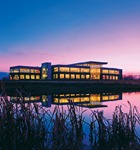
Neumann/Smith’s design of the headquarters for Centurion Medical Products, sited on 37 wooded acres, was selected as the 2010 Green Project of the Year by CAM Magazine. Photo: Justin Maconochie, Maconochie Photography.
With the recent recession, there has been a shift in corporate office design, says Gene Carroll, AIA, LEED AP, a partner at Neumann/Smith Architecture. As many companies shed their office space or renovate for more energy efficiency, Carroll’s firm is reaching out to clients to help them create more sustainable, high-performance work areas. “The cost of energy, real estate, technology, and the environment are becoming more important to our clients,” Carroll says. And in order to meet increasing sustainable demands, more than 60 percent of Neumann/Smith’s architects and interior designers have become LEED accredited; the goal is to reach 100 percent accreditation by 2012.
Founded in 1968 by Ken Neumann and Sanford Rossen, Neumann/Smith Architecture has weathered numerous changes in the design industry over the past 40 years to become one of Michigan’s largest architectural firms. The firm has ensured its continued success through a collaborative approach and a promotion of sustainable architecture, and nowadays it works on a variety of large-scale projects, including medical facilities, educational housing, and commercial office space.
In 2010, CAM Magazine selected the firm’s Centurion Medical Products Headquarters as its 2010 Green Project of the Year. The two-story, 120,000-square-foot, LEED Gold-certified building is sited on 37 wooded acres; it has raised floors for easy access to mechanical, electrical, and data systems; and its efficient skin has an R value 28 percent higher than required by code. The clerestory glass in the two-story atrium running through the middle of the building brings daylight into the interior. In addition to the corporate offices, there is also a 3,000-square-foot fitness center, an outdoor track along the site’s perimeter, and a two-story atrium with a café and water feature.

The LEED Gold Centurion building features an ultra-efficient skin that makes it 28% more efficient than required by code. Inside, clerestory glass in the two-story atrium brings in ample daylight. Photo: Justin Maconochie, Maconochie Photography.
Another of the firm’s LEED Gold projects is Michigan Technological University’s Hillside Residence Hall, which received certification in 2011. Along with its energy-efficient strategies implemented for LEED certification, the project incorporated details and materials not typically used in student housing and more in keeping with an “up north” aesthetic, including sloped metal roofs, stone walls, and exposed wood decking. Glass-clad walls and towers were inspired by historical fire-lookout towers once common to the forestry industry in the Upper Peninsula of Michigan.
Within the past three years, Neumann/Smith has moved beyond its Michigan base into both neighboring and far-flung states. According to Carroll, “As many of our clients moved outside of Michigan, we saw opportunities to move with them. With the development of our educational expertise, we are looking to serve higher-education clients on a national level.”

Michigan Technological University’s Hillside Residence Hall targeted energy efficiency to secure LEED Gold certification and also fits into the school’s modern architectural style but also evokes a distinctively northern aesthetic with elements such as sloped metal roofs, stone walls, and wood decking. Photo: Mark E. Riutta.
Right now, nearly 50 percent of the firm’s workload is already in higher-education design, and, according to Carroll, the national conversation in the past five years has brought a significant increase in requests for LEED certification. Neumann/Smith expects to continue growing its higher-education practice nationally because universities not only have to maintain classroom structures but also all ancillary needs, such as parking structures, student centers, and laboratories. Universities and community colleges need to remain competitive in the marketplace while maintaining control of rising energy costs, so many of their aging buildings require replacement or renovation. “It’s a market we feel we can provide great value to,” Carroll says. “They have dozens and dozens of buildings with huge energy requirements. They simply can’t afford high maintenance and energy costs.”

